Carnation Shabo: features, types, planting and care

The common carnation has been known since antiquity. In those days, flowers were used in cooking. After all, cloves were the most accessible seasoning that gave dishes a unique taste and aroma. Epochs changed, oriental spices became available to Europeans, and carnations began to perform a decorative function. New varieties were bred, one of which is the Shabo carnation with sloping petals, delicate aroma and long flowering.

Description
Carnation Shabo was bred in the 19th century by the pharmacist Shabo from Toulon... The Frenchman crossed two hardy species, obtaining a herbaceous perennial of hybrid origin. The flower immediately fell in love with gardeners and landscape designers. To this day, balconies and flower beds, gazebos and terraces are decorated with Shabo carnations. She is used to decorate the ridges - rectangular flower beds in the form of narrow strips along the paths of the garden, fences or fences.
Shabo carnations are planted in mixborders - complex flower beds in which plants are planted in several tiers and bloom from early spring to mid-November. Europeans attribute the Shabo carnation to the garden variety. In Russia, it is considered a separate representative of the clove family. Experts admit that both points of view have a place to be, because this does not affect the beauty of the plant.
The plant is actively used in decor due to its varied color range, which includes both delicate pastel tones and bright saturated shades. In addition to the usual pink and red carnations, there are yellow, purple, beige and white.


This variety allows you to create not only various patterns, but also volumetric compositions or thematic images.
It is worth getting to know the "anatomy" of this interesting plant. For example, it receives nutrients from the lower layers of the soil, thanks to a long root (it lies at a depth of 10-20 cm). From the root, there are long, strong stems (about 30-70 cm), on which buds bloom. The diameter of the latter is 6-8 cm. The Shabo carnation blooms from the top of summer to the very frost, and the seeds are formed one and a half to two months after the beginning of flowering. Seed germination lasts for three years.
In hot weather, the flower is saved from drought with the help of thin linear bluish-green leaves collected at the base of the bush. Thanks to them, the soil is in the shade, which reliably protects it from drying out. The exquisite aroma of Shabo cloves leaves no one indifferent. It is no coincidence that the petals get a second life after flowering: fragrant sachets are made from dried petals, which are used as a natural flavoring agent. In some cases, it is allowed to use the original decorated clove sachets as an organic addition to the interior.

Varieties
This perennial plant is grown both for the garden and for bouquet arrangements. High varieties are used to decorate bouquets, and low-growing ones decorate flower beds, flower beds and alpine slides. Low types of Shabo carnations are grown in pots and flowerpots, landscaping terraces and gazebos, loggias and balconies with them. It is worth getting to know its popular varieties better.
- The height of the bushes of most species is 30-50 cm, the diameter of the flowers is up to 8 cm.The frost-resistant "Watercolor" with pale pink, white, red and variegated flowers.It is used to decorate flower beds and flower beds; it can be grown as a houseplant.



- Dense double golden yellow Champagne differs in great unpretentiousness and good immunity. It grows quickly, it is easy to care for it - it is no coincidence that novice gardeners simply adore it.




- Flowers "Giant Terry Cloves" pleasing to the eye from August to October. It is decorated with hedges and borders.




- Yellow or purple flowers Lyon they take root well in regions with a cool climate.


- "The Pink Queen" with its bright pink flowers will adorn any flower arrangement. Moreover, it can be either an originally decorated flower bed or a flowerpot placed in a garden flower garden.




- Large inflorescences "Disco" suitable for a bouquet. This biennial blooms from July to late autumn. However, experienced gardeners know how to prolong the pleasure. They dig the plant out of the ground, transplant it into a flowerpot, put it in a cool room and it blooms until the New Year.


- Half-meter Mont Blanc produces up to twenty buds, the diameter of which is 6 cm. Lush white inflorescences resemble boiling white snow sparkling on the mountain peak of the same name.
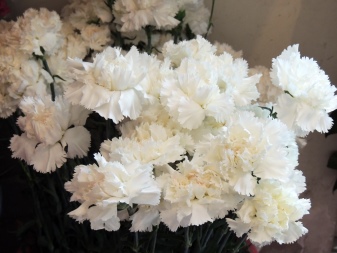



- Incredibly fragrant inflorescences differ "Pikoti fairy tale"... Large double flowers of this variety most often have a double color: white with crimson, yellow with pink. The diameter of the flowers is 6-7 cm, all flowers are collected in lush inflorescences.


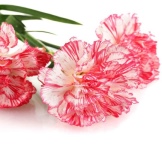

Such splendor - the eyes run up. but novice gardeners should pay attention to the most unpretentious types of plants... These, in addition to Champagne, Aquarelle and Mont Blanc, include Lejeune D Oner with dark cherry flowers, Marie Chabot with a rich bright yellow hue. "Girofle" pleases the eye with its original purple, "Mikado" - lilac, "Fire King" - an orange tint. La France is characterized by candy pink rosettes, Nero by black and red, and crimson Ruby by deep red colors.
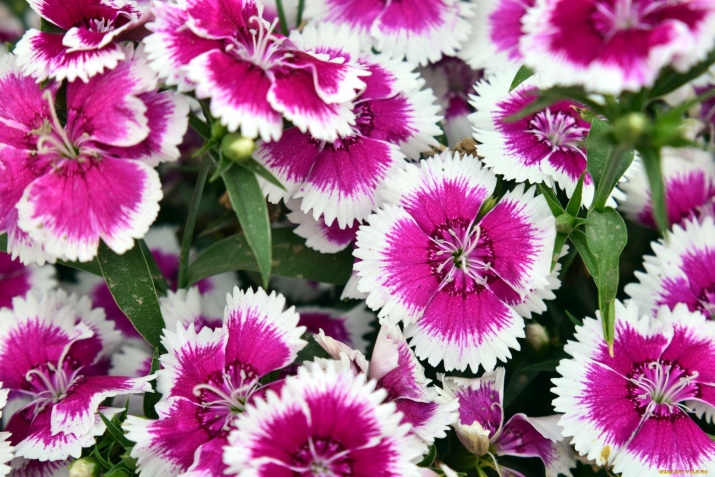





Growing conditions
It will be useful for novice flower growers to know about the peculiarities of carnation for Shabo carnations. At home, it must be kept cool and on a brightly lit windowsill. It is not easy to create such conditions in a stuffy city apartment. And if the flower stands on a window facing the north side, it will also suffer from a lack of light. In order not to torment the plant, it is better to immediately plant it in open ground in the most illuminated area. It is no coincidence that it is called a garden.


Carnation is a hardy plant, but you will have to try to get a luxurious flowering. In hot weather, the soil should be watered regularly, but without fanaticism. If the weather is cool with frequent rains, watering is reduced or stopped. The soil must be periodically loosened and mulched (covered with natural organic materials such as straw or hay), and top dressing must be applied.
Cloves are fed two weeks after planting in open ground with nitrogen fertilizers and several times during the budding period with mineral fertilizers.


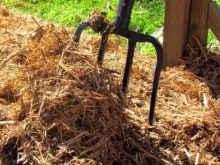
Higher grades need to be tied up or put on plastic support. The buds that have faded must be removed. With the onset of frost, flowering bushes must be dug out of the ground, transplanted into flowerpots and carried to a cool loggia or balcony. Then the flowering period will last until the New Year holidays.
After transplanting into a pot, the cloves should be cut by a third and the watering regime should be adjusted. At first, it is watered often, but little by little, then the amount of watering is reduced, and the plant is placed in a cold room. From about mid-February, the cloves should be returned to warmth and watered abundantly. In order for the carnation to please in the spring with its rapid flowering and growth, it is necessary to make a top dressing for flowering plants. Part of the shoots is cut for grafting, dried shoots are removed.


How to plant?
Shabo cloves are traditionally grown from seeds. Even before the New Year, flower growers begin to prepare everything they need, and after the New Year holidays they start planting seeds. Preparing the soil, planting and caring for seedlings is troublesome, but not difficult, which even a novice amateur gardener can handle. You just need to follow the instructions and not deviate from the rules.

Preparation and sowing
At this stage, you need to choose the right soil. A loose substrate with neutral acidity is best suited, which absorbs well and retains moisture for a long time. This soil can be purchased at any flower shop. The soil mixture can be made independently from two parts of turf, peat and humus and one part of coarse sand.
The height of the planting containers should not exceed 5 cm. Any containers, jars, bowls, glasses and boxes will do. To prevent the appearance of pests, the containers should be rinsed with a weak solution of potassium permanganate. Immediately before planting the seeds, a drainage layer is laid on the bottom of the selected containers, and the soil is moistened. Carnation seeds are laid out on top of the ground with a step of 2 cm from each other, and then sprinkled with a thin layer of calcined sand (prevention from black leg).
After that, each container is closed with a film or a transparent lid.

The substrate should be moistened only as it dries. Watering is carried out in the morning from a spray bottle. Condensation must be removed to prevent rotting. If everything is done correctly, the first shoots appear in 10-12 days. To protect them from bacteria, the soil should be sprinkled with crushed coal. Young leaves are formed within a month. In order for the seedlings to grow into a strong healthy plant, they are hardened by opening the film or lid.
On the first day, the hardening time will be 10 minutes, on the second - 15, on the third - 20, and so on. The protective film is removed when the plant has been left open for 60 minutes. The most difficult part of growing plants from seeds is to provide good conditions for their development. For example, the room should not be hot (from the strength of 10-15 degrees). The room or balcony should be well ventilated. If the weather is cloudy outside, you need to provide the plants with artificial lighting.


Picking
As the seedlings grow, they need to be thinned out. The first pick is carried out after the formation of a pair of true leaves, when the seedlings are seated in separate containers to a depth of 2 cm. The second is carried out in the third decade of March, when four pairs of full-fledged leaves have formed in the seedlings. Young plants are transplanted into pots with diameters from 10 cm.The planting depth remains the same - 2 cm.
When another pair of leaves appears, the seedlings are pinched - this is necessary for the formation of lush and compact bushes. When it gets warmer outside to 10-12 degrees, the plants in pots should be taken out to the loggia or on the balcony and hardened there for two hours. This hardening promotes better growth and lush flowering of the carnation. And hardened plants are almost not susceptible to disease and do not suffer from the vagaries of the weather.

Landing
The place for the future flower garden should be prepared in advance. Perfectly - since last autumn, the earth should be dug up with a mixture of 20 kg of rotted manure and 50 g of superphosphate... When the snow melts, add a mixture of 25 g of potassium sulfate and 15 g of ammonium nitrate (the amount of fertilizer is indicated per 1 sq. M). Carnation Shabo grows well on loose loam. But if the soil is acidic and dense on the site, peat and dolomite flour should be added to it.
Young carnations should be planted on the site only in the second decade of May, when the ground warms up well. Each plant should be relocated along with an earthen clod. The distance when planting between seedlings is up to half a meter, the root collar does not need to be buried. For 1 sq. m should have no more than 16 plants.
So that the perennial does not freeze, it is covered with lutrasil - a non-woven, fibrous material that passes both air and water equally well.

How to take care of it properly?
Carnation Shabo is a hardy perennial, but it is not easy to grow it, because, like any plant, it requires attention and care. Only with proper care will it delight with lush and long flowering. That's why beginners should familiarize themselves with the step-by-step instructions, which describe the rules for caring for this beauty.
Watering
Watering should be abundant and systematic. If it's a dry summer outside, you can water your carnation twice a week. If it rains periodically, the number of waterings can be reduced to one. And if it is inclement rainy weather, the plant need not be watered at all. Moistened soil should be loosened immediately. This will protect the roots from oxygen starvation, and the plant will grow strong and healthy.
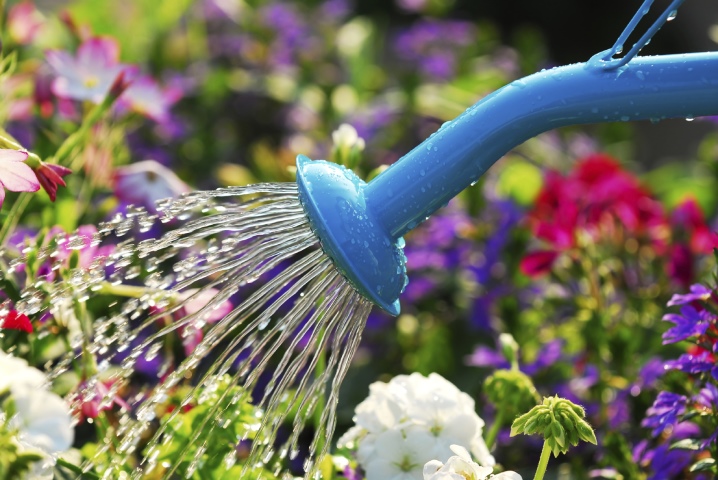
Top dressing
A week after planting in open ground, the plant must be fed with nitrogen fertilizer (15 g per 1 sq. M). When the first ovary appears, a mineral dressing is introduced - a mixture of ammonium nitrate and potassium sulfate (15 g per 1 sq. M).

Fertilizers
To maintain flowering and the formation of new buds, complex mineral fertilizers should be applied every three weeks.
In this case, biological additives are not used. You don't need to make organic mixtures.


Transfer
To transplant a plant from the soil into a pot, you should carefully dig it up, place it with an earthen clod in a pot or flowerpot and take it home. The Shabo carnation can also be located on an insulated veranda, terrace or loggia. It is allowed to leave it on the glazed balconies. It is not recommended to put it in the basement - this light-loving plant may not survive wintering in complete darkness. Every two years, the plant is transplanted to another place, otherwise the flowering stops.

Preparing for winter
If it is supposed to leave the plant for wintering in the open field, the gardener will have to perform a number of simple operations. When the carnation has faded, you should cut the bushes by a third and at the same time remove the faded buds. The shoots must be carefully tilted and sprinkled with a layer of soil (about 20 cm). From above, cover the cloves with a layer of straw or hay 50 cm thick. Such a “blanket” will help the plant survive the winter cold. It is harvested in the spring after the snow melts. And when the frosts pass, you can free the shoots themselves. The bushes should be carefully examined and any damaged shoots should be removed.
The Shabo carnation is not an easy crop to grow. But the time and financial costs will not be in vain: the beauty of the plant, its lush flowers and exquisite aroma will make you forget about all the twists and turns.
Yes, and the endurance of the carnation does not take, because not every plant will take root in any climatic conditions.

How to propagate?
The mature Shabo carnation plants bloom profusely and form capsules with numerous seeds. However, collecting them is not worth it - plants grown from seeds may turn out to be either weaker, or they will be of a different color. That's why Shabo cloves should be propagated vegetatively (using cuttings).
- The bush for propagation should be selected in advance. In the fall, it should be placed in a pot, cut off the shoots and taken to the house. The plant should be in a well-lit, cool place. The ideal temperature is 10-12 degrees.
- In the spring, cuttings are cut from the mother part of the plant. The sections are treated with "Kornevin", the lower leaves are removed.
- The stalk is planted in pre-calcined and moistened sand. Cover the top with a glass jar or plastic bottle. Every day, the "greenhouse" should be ventilated, and the sand should be moistened as it dries.
- After about a month (the timing depends on the conditions of care), roots appear and a bush begins to form.
- When the first shoots appear, the seedlings are given air baths every day and gradually increase the time. When the sprouts get used to normal conditions, the jar or bottle should be removed.
- The cuttings are planted in open ground in early June.
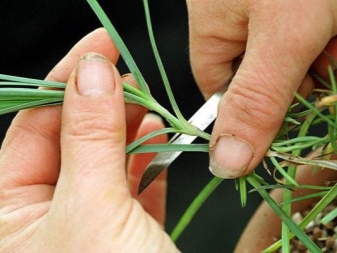

Gardeners argue that this breeding method has one drawback - the bushes bloom early, but not abundantly. There is another option: cut the cuttings in the fall and grow them at home. However, this method is considered the most difficult and almost no one uses it.
Diseases and pests
The Shabo carnation is distinguished by enviable health. Yet it is also susceptible to a number of diseases. For example, on hot rainy days, the risk of fungal infections increases. In most cases, it is an alternariosis - it is easily recognizable by its characteristic dry brown or black spot on the leaves and shoots. Carnation can suffer from rust, which can be easily identified by light to yellowish-brown spots on the top and inner surfaces of the leaves. Sick plants should be removed from the flower bed, and healthy plants should be treated with Bordeaux liquid or copper sulfate.
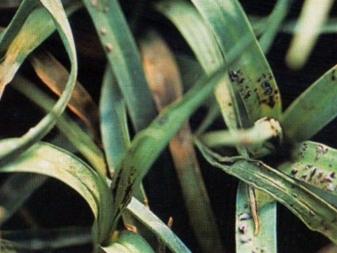

The Shabo carnation has succulent leaves that aphids, mites and thrips find very attractive. You can get rid of uninvited guests with folk remedies. A solution of laundry soap, tobacco tincture, a mixture of onion peels and garlic are suitable. However, these methods are good if there are few pests on the plant. If a large colony has managed to breed, you should use chemical means of protection - "Aktellika", "Aktar" or "Karbofos". After 4-5 days, the treatment should be repeated.


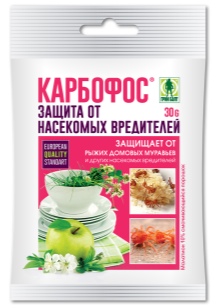
Since any disease is easier to prevent than to cure, it is worth taking care of disease prevention. For example, clove seeds should be treated with a weak solution of potassium permanganate. From grown plants, faded inflorescences and wilted leaves should be removed. After each watering and after heavy rainfall, the soil should be loosened. Finally, it is imperative to regularly inspect the plants in order to take up the treatment on time. It is not forbidden to regularly spray flowers with a solution of laundry soap.
This will show the beetles that they are not welcome here, and the flowers will delight the owner with the beauty of flowering until late autumn.


Use in landscape design
Today it has become fashionable to plant balconies and loggias, create various flower arrangements and arrange alpine slides. A beautiful lawn is no longer a luxury available only to the elite. Everyone can create this beauty. Here are some examples of flower beds that will inspire you to create your own little Versailles.
- The most ordinary greenhouse, along which Shabo carnations are planted. Gray background and bright flowers. Nothing extra. The best option for a small suburban area.

- A stunning contrast - rough stones and delicate flowers. The composition resembles the ruins of an ancient castle overgrown with grass and flowers. An interesting solution for romantic people.

- Shabo carnation mixborder. Tall plant, rich colors. The original border and decoration of the site. Suitable for any area.

- An option for those who do not want to spend time and effort on creating a flower bed, but want to plant a beautiful plant: a pale pink island stands out brightly against the gray earth. The surrounding greenery emphasizes the tenderness of the flowers and the brightness of the color.
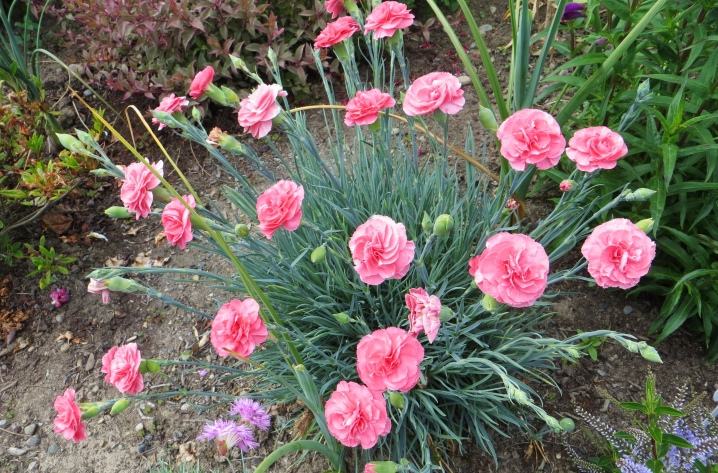
- The Shabo carnation will look good even if there are no other plants nearby. Delicate flowers are organically combined with the gray color of the earth. Simple and beautiful.

- You may not even be transplanting a plant into open ground at all. It is enough to put it in a spacious flowerpot and expose it to fresh air.
An excellent solution for the laziest.
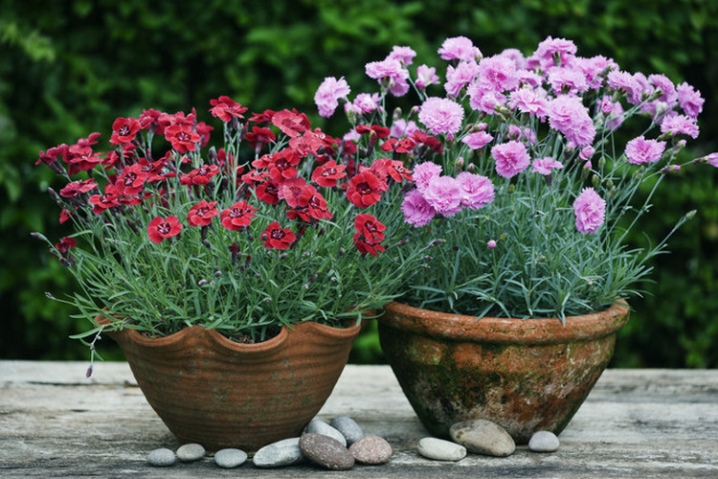
- A bright decoration of any balcony, without fancy and embellishment. The choice of those who do not have the opportunity to plant a plant in open ground outside the city.

Features of Shabo clove in the next video.







































































































The comment was sent successfully.